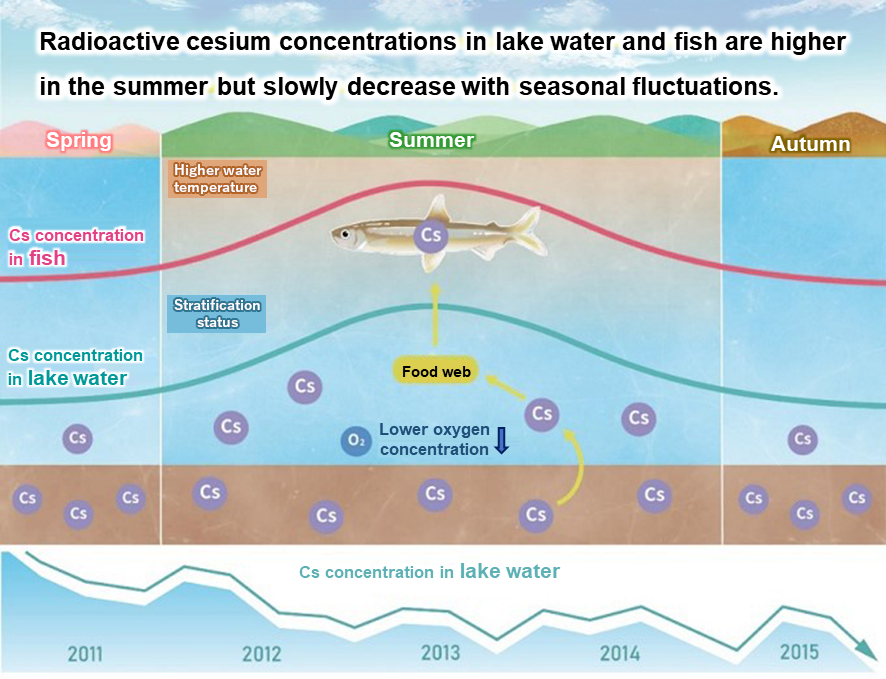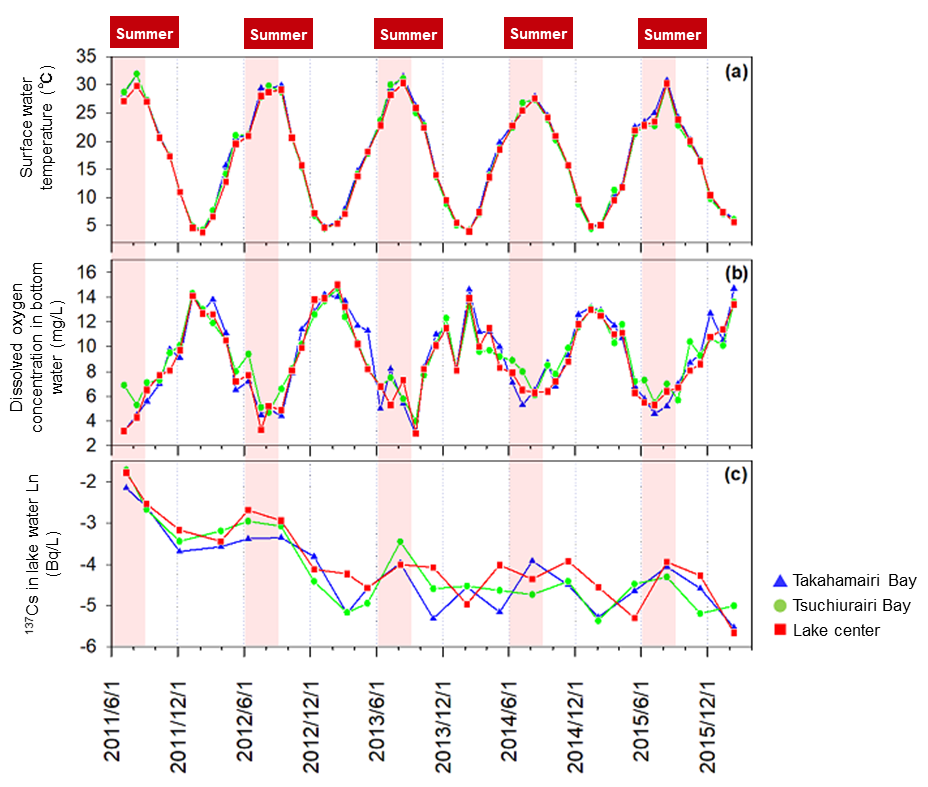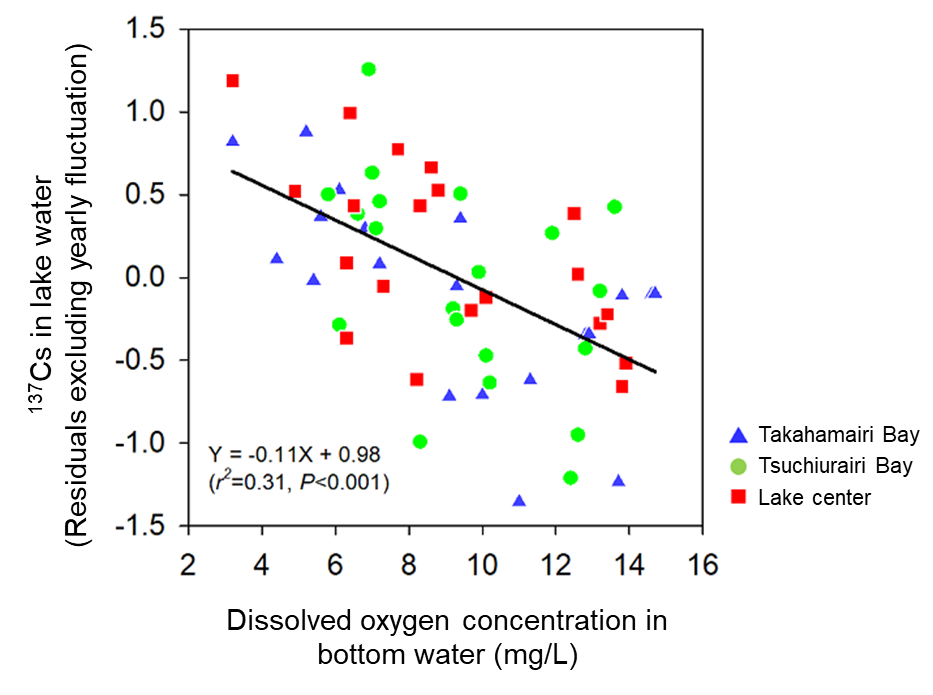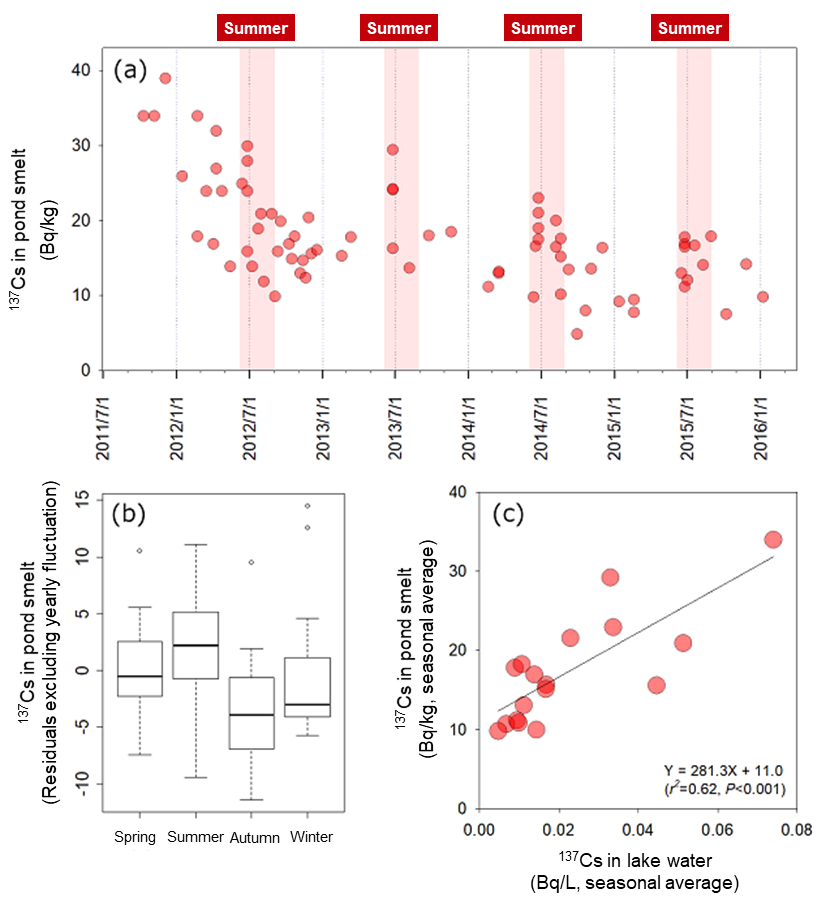Effects on Ecosystem
(2020)
QDo radioactive cesium concentrations in lake water and fish change seasonally? 【Study results for Lake Kasumigaura, Ibaraki Prefecture】
AThe National Institute for Environmental Studies continued the observation of the concentration of radioactive cesium (in a dissolved state) in the waters of Lake Kasumigaura (Lake Nishiura), Ibaraki Prefecture, for five years after the Fukushima nuclear accident.
The results revealed that radioactive cesium concentrations in the lake water were slightly higher in the summer than in the other seasons, and so were the radioactive cesium concentrations in fish in the lake (although these levels were far below the limits set for radioactive materials in drinking water and aquatic products).

Fig.1 Conceptual image of changes in radioactive cesium concentration in lake water and fish
Radioactive cesium concentrations in lake water and fish are slowly decreasing with seasonal fluctuations.

Fig.2 Observation at three points of Lake Kasumigaura:
(a) Monthly surface water temperature
(b) Monthly change in dissolved oxygen concentration in bottom water
(c) Seasonal change in dissolved 137Cs concentration in lake water
Pink vertical bands represent the summer months (June to August).
From 2011 to 2016, environmental measurements (e.g., monthly water temperature and dissolved oxygen concentration) were conducted at three points in Lake Kasumigaura (lake center, Takahamairi Bay, and Tsuchiurairi Bay). The concentration of radioactive cesium dissolved in lake water was also measured through seasonal sampling of surface water (0-2 m water column).
The results indicated a rise in surface water temperature and a decline in dissolved oxygen concentration in bottom water (around 10 cm from the lake bottom) in the summer (Fig. 2-a and -b).
The study revealed that radioactive cesium concentrations in the lake water sharply decreased in one to two years after the Fukushima nuclear accident and have been slowly decreasing since then with seasonal fluctuations with small summer peaks (Fig. 2-c).

Fig.3 Relationship between dissolved 137Cs concentration in lake water and dissolved oxygen concentration in bottom water at three points in Lake Kasumigaura
An analysis of changes in the radioactive cesium concentration in lake water indicated a significant negative correlation between the dissolved oxygen concentration in bottom water and the radioactive cesium concentration in lake water (Fig. 3). The study also confirmed that changes in dissolved oxygen concentration in bottom water influenced the radioactive cesium concentration in lake water.
Dust raised by the wind and influx of water from rivers can be factors affecting the radioactive cesium concentration in lake water. However, no significant correlation was found in any of the following pairs: wind velocity and the dissolved oxygen concentration in bottom water; wind velocity and the radioactive cesium concentration in lake water; or the flow rate of major rivers flowing into the lake and the radioactive cesium concentration in lake water.
These findings suggest that in Lake Kasumigaura, radioactive cesium leaches out of sediments when the dissolved oxygen concentration in bottom water substantially decreases in the summer. However, even when radioactive cesium concentrations rise due to leaching from sediments, there is no concern about everyday water usage (for drinking, irrigation, etc.) because the measured concentrations were far below the 10 Bq/L limit for drinking water.

Fig.4 (a) Chronological changes in 137Cs concentration in pond smelt caught in Lake Kasumigaura
(b) Seasonal difference in 137Cs concentration in pond smelt
(c) Relationship between the radioactive 137Cs concentration in lake water and the 137Cs concentration in pond smelt
In shallow, eutrophic lakes like Lake Kasumigaura, temporary stratification occurs during summer, when surface water temperature rises while a lack of oxygen occurs in the bottom water. However, once strong winds blow or the surface water temperature changes, stratification breaks down, causing the surface and bottom water to mix again.
It is assumed that in Lake Kasumigaura, unlike in deep lakes, stratification and mixing frequently occur, and radioactive cesium leached into water through this process repeatedly moves to the surface water.
This study pointed out that the leaching of radioactive cesium occurred even in a shallow lake and that such leached radioactive cesium could influence the seasonal fluctuation of radioactive cesium concentrations in lake water and fish.
These findings are expected to help elucidate the factors of low-level radioactive contamination of fish over the long term as well as contribute to more accurate predictions of radioactive cesium dynamics. Where shipping restrictions are imposed on fish and other aquatic products, seasonal fluctuations, such as those revealed in this study, may be taken into consideration to enable more accurate prediction of the time to lift such restrictions.
Given that the oxygen environment in the bottom water dynamically changes in short cycles in shallow lakes, we can expect that frequent (e.g., hourly or daily) measurement of dissolved oxygen concentrations in the bottom water, radioactive cesium concentrations in lake water, and other related indicators will help clarify detailed processes and mechanisms associated with them.
(Research results of the National Institute for Environmental Studies)
Related articles
- What conditions influence the radioactive cesium concentration in freshwater fish?
- How is the concentration of radioactive cesium in river fish changing over time?
- Where does the radioactive cesium taken in by mountain stream fish come from? How will the cesium concentration in them change in the future? 【Example of analysis】
- How is the concentration of radioactive cesium in marine species changing?
